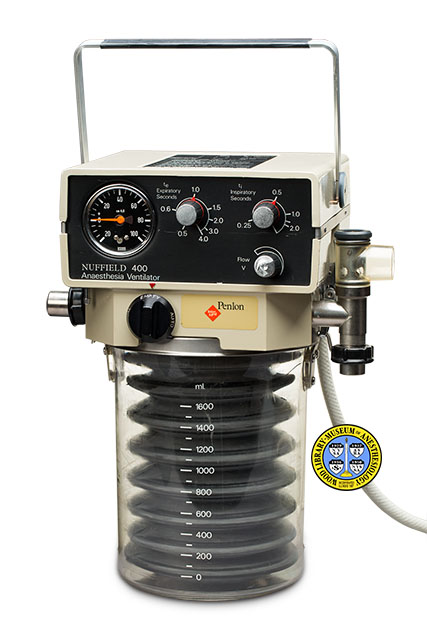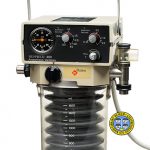Nuffield 400 Ventilator
Mechanical ventilators have been a component of anesthesia machines since the 1950s. Some feature a bellows that descends from the top of the apparatus when air and anesthetic gases are pushed into the patient's lungs and retracts upward as gases are pushed out again. Some feature a bellows that ascends from the bottom during inspiration and falls during expiration. The Penlon Nuffield 400 Anaesthesia Ventilator has a descending bellows.
The Nuffield Department of Anaesthetics was founded at England's University of Oxford in 1937. Several local manufacturing firms were created to make anesthesia equipment designed by the Nuffield staff. Among these were Longworth Scientific Instrument Co. and Pentland Instrument Co. Longworth later acquired Pentland, and around 1970 the name was changed to Penlon. By 1975 Penlon had been acquired in turn by InterMed.
In the 1980s, Penlon InterMed introduced its 200, 300 and 400 series of anesthesia ventilators. The 200 was made for use with both adult and pediatric patients, the 300 for use with pediatric patients only, and the 400 for use with adult patients only. The 200 and 400 were named in honor of the Nuffield Department. Through the 1990s the Nuffield 400 was the most widely-used ventilator of this type in the United Kingdom, but by 2005 the descending bellows design was out of favor. Penlon continues to make the Nuffield 200 Ventilator today.
Catalog Record: Nuffield 400 Ventilator Nuffield 400
Access Key: aqsy
Accession No.: 2005-06-28-3
Title: Nuffield 400 anaesthesia ventilator / Penlon InterMed.
Corporate Author: Penlon InterMed.
Publisher: Abingdon, Oxfordshire, England : Penlon InterMed, [between 1980 and 2005].
Physical Description: 1 ventilator : metals, plastics, rubber ; 49 x 116 x 113.5 cm.
Subject: Ventilation, Mechanical.
Subject: Ventilators, Mechanical.
Subject: Respiration, Artificial – instrumentation.
Note Type: General
Notes: The title and publication data are taken from the object.
The first year in the range of possible dates of manufacture is based on the earliest published references to this model found by the cataloger. The second year in the date range is based on date of acquisition; the actual year of manufacture is likely to have been somewhat earlier.
Described from the user’s perspective, with the controls facing forward.
Note Type: Citation
Notes: Beinart J. A History of the Nuffield Department of Anaesthetics, Oxford 1937-1987. Oxford: Oxford University Press, 1987.
Note Type: Citation
Notes: Davey AJ, Riley B. Mechanical ventilation with air-oxygen mixtures during total intravenous anaesthesia: An evaluation of the Penlon Nuffield ventilator. Anaesthesia. April, 1983;38(4):355-360.
Note Type: Citation
Notes: Davey AJ, Moyle JTB, Ward CS. Ward’s Aneasthetic Equipment, 3rd ed. London: W. B. Saunders Company, Ltd., 1992:219-221.
Note Type: Citation
Notes: Davey AJ, Diba A. Ward’s Aneasthetic Equipment, 5th ed. Edinburgh: Saunders Elsevier, 2005:252.
Note Type: Citation
Notes: Moyle JTB, Davey A. Ward’s Anaesthetic Equipment, 4th ed. London: W. B. Saunders Company Ltd., 1998:206-209.
Note Type: Citation
Notes: Penlon Company File. Archives. Located at: Wood Library-Museum of Anesthesiology, Schaumburg, Illinois.
Note Type: Physical Description
Notes: One ventilator; The height given in the short physical description is that with the handle standing upright; With the handle folded down the height is approximately 37 centimeters; The width given in the short description is that with the hose extended toward the right; The width with the body of ventilator is approximately 28 centimeters; The depth given in the short description is that with the hose extended toward the back; The depth of the body of the ventilator is approximately 28 centimeters;
The housing of the head unit is made of putty-colored metal; The shape of this unit is that of a rectangle mounted on a hexagon; A label on top of the head unit provides a diagram and states: “IMPORTANT: ALWAYS [new line] ensure ventilator is securely mounted in a vertical position [new line] check drive gas is Oxygen or Medical Air (clean, dry, and oil free) at a pressure of 290-650kPa [new line] ensure bellows canister is securely fastened [new line] check connections to anaesthetic circuit are correct and secure [new line] pause at ‘EMPTY’ mode when changing from ‘MANUAL’ to ‘AUTO’. [new line] REFER TO INSTRUCTION MANUAL FOR COMPLETE OPERATING INSTRUCTIONS”;
The front of the upper, rectangular portion of the head holds four components; From left to right, these are: a pressure gauge marked: “20 , 0 , + 20, 40, 60, 80, 100”; a dial marked: “te Expiratory Seconds, 0.5, 0.6, 1.0, 1.5, 2.0, 3.0, 4.0, cm H2O”; a dial marked: “ti Inspiratory Seconds, 0.25, 0.5, 1.0, 2.0”; and a knob marked “Flow V”; Below the gauge it is marked: “NUFFIELD 400 [new line] Anaesthesia Ventilator”; Below this, the hexagonal portion holds two components; That on the left is identified on the diagram as the “Manometer Connection”; To the right of this is a dial marked: “MANUAL, EMPTY, AUTO”; To the right of this dial appears the Penlon InterMed logo;
The left side of the head unit holds the component identified on the diagram as the “Anaesthetic Circuit Connection”; The right side of the head holds the components identified as the ventilator exhaust and the connector for the reservoir bag; An adhesive label on the right side states, in part “Medigas Alberta, Ltd.”; The back of the head unit holds the component identified as the “Drive Gas Inlet”; The inlet port is connected to a white vinyl hose, approximately 102 centimeters long; The hose is marked “PENLON ANTI-STATIC”; This inlet is mounted near the left edge of the back of the unit; Above this there is a second “Medigas” label; To the right of this label is a bracket that enables the unit to be mounted on a pole; To the right of this is a metallic label plate marked: “[Penlon InterMed logo] Made in England [new line] Abingdon, Oxon, OX14 3PH Tel(0235)24042 [new line] Telex 837129 [new line] Tested by RAB, Serial No. N0181-01”;
Below the head unit is a transparent plastic cylinder (the canister) marked, from the bottom up: “0, 200, 400, 600, 800, 1000, 1200, 1400, 1600, ml.”; This cylinder encloses a black rubber bellows, which is fully extended; Two metal hooks, mounted on opposite sides of the cylinder, hold the latches that are mounted on the head unit.
Note Type: Reproduction
Notes: Photographed by Mr. Steve Donisch, January 15, 2018.
Note Type: Historical
Notes: Anesthesiologists are responsible for maintaining the patient’s respiration and other vital functions during inhalation anesthesia. Mechanical ventilators can either assist a patient to breathe, or control a patient’s breathing. Ventilators have been a component of anesthesia machines since the 1950s, when an international polio epidemic prompted rapid developments in this technology. Some feature a bellows that descends from the top of the apparatus when air and anesthetic gases are pushed into the patient’s lungs and retracts upward as gases are pushed out again. Some feature a bellows that ascends from the bottom during inspiration and falls during expiration. The Penlon Nuffield 400 Anaesthesia Ventilator has a descending bellows.
The Nuffield Department of Anaesthetics was founded at England’s University of Oxford in 1937. In the 1940s and ’50s, several local manufacturing firms were formed to make anesthesia equipment designed by the Nuffield staff. Among these were Longworth Scientific Instrument Co. and Pentland Instrument Co. Around 1960, Longworth acquired Pentland and adopted the Penlon logo. The Company name was changed from Longworth to Penlon around 1970, and by 1975 Penlon had been acquired in turn by InterMed.
In the 1980s, Penlon introduced its 200, 300 and 400 series of anesthesia ventilators. The 200 was made for use with both adult and pediatric patients, the 300 for use with pediatric patients only, and the 400 for use with adult patients only. The 200 and 400 were named in honor of the Nuffield Department. The cataloger was unable to determine whether members of the Department’s staff were involved in the design of these ventilators. Through the 1990s the Nuffield 400 was the most widely-used descending bellows ventilator for adults in the United Kingdom, but by 2005 the descending bellows design was out of favor. Penlon continues to make the Nuffield 200 Ventilator today.
Note Type: Exhibition
Notes: Selected for the WLM website.


